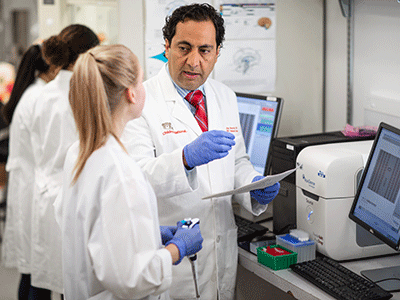Q&A with Dr. Javad Nazarian on his upcoming work on low-grade gliomas

Supported by the Gilbert Family Foundation, Dr. Nazarian’s return is part of a special research program within the Gilbert Family Neurofibromatosis Institute that focuses on NF1 research.
Javad Nazarian, Ph.D., M.Sc., associate professor of Pediatrics at George Washington University and professor at the University of Zurich, has expanded his research group at Children’s National to focus on Neurofibromatosis type 1 (NF1) transformed low-grade gliomas (LGGs). Dr. Nazarian will apply his expertise from establishing a successful DIPG (diffuse intrinsic pontine glioma) and DMG (diffuse midline glioma) program in Zurich Switzerland and previously at Children’s National.
In addition to his continued research in Zurich, as a principal investigator at the Department of Genomics and Precision Medicine at Children’s National Dr. Nazarian plans on aggregating his knowledge to the new research and work spearheaded at Children’s National. As one of the first research teams to move to the Children’s National Research & Innovation Campus, Dr. Nazarian’s group is excited to use the opportunity to establish cutting-edge and clinically translational platforms.
Supported by the Gilbert Family Foundation, Dr. Nazarian’s return is part of a special research program within the Gilbert Family Neurofibromatosis Institute that focuses on NF1 research. This research includes associated gliomas with a special emphasis on NF1-associated transformed anaplastic LGGs. His team will develop new avenues of research into childhood and young adult NF-associated LGGs with a special emphasis on transformed high-grade gliomas.
Dr. Nazarian is excited for what’s to come and his goals are clear and set. Here, Dr. Nazarian tells us more about his main objectives and what it means for the future of pediatric neuro-oncology care at Children’s National.
- What excites you most about being back at Children’s National?
I have received most of my training at Children’s National, so this is home for me. Being one of the nation’s top children’s hospitals gives a unique advantage and ability to advocate for childhood diseases and cancers. It is always exciting to play a part in the vision of Children’s National.
- What are some of the lessons learned during your time working in Zurich? And how do you think these will compliment your work at Children’s National?
We developed a focused group with basic research activities intertwined with clinical needs. The result was the launch of two clinical trials. I also helped in developing the Diffuse Midline Glioma-Adaptive Combinatory Trial (DMG-ACT) working group that spans across the world with over 18-member institutions that will help to design the next generation clinical trials. I will continue leading the research component of these efforts, which will have a positive impact on our research activities at Children’s National.
- How does your work focusing on low-grade gliomas formulating into high-grade gliomas expand and place Children’s National as a leader in the field?
Scientifically speaking, transformed LLGs are very intriguing. I became interested in the field because these tumors share molecular signatures similar to high-grade gliomas (HGGs). Our team has done a great job at Children’s National to develop tools – including biorepositories, avatar models, drug screening platforms, focused working groups, etc. – for HGGs. We will apply the same model to transformed LGGs with the goal of developing biology-derived clinical therapeutics for this patient population.
- How will this work support families and patients seeking specific neuro-oncology care?
We will develop new and high thruput tools so that we can better study cancer formation or transformation. These tools and platforms will allow us to screen candidate drugs that will be clinically effective. The main focus is to accelerate discovery, push drugs to the clinic, feed information back to the lab from clinical and subsequently design better therapies.
- You are one of the first scientists to move to the Children’s National Research & Innovation Campus. What are some of the valuable changes or advancements you hope to see as a result of the move?
The campus will provide high-end facilities, including cutting-edge preclinical space, and allow for team expansion. The close proximity to Virginia Tech will also provide an environment for cross-discipline interactions.
- Anything else you think peers in your field should know about you, the field or our program?
The team at Children’s National includes Drs. Roger Packer and Miriam Bornhorst. Both have provided constant clinical support, innovation and clinical translation of our findings. I look forward to working with them.



